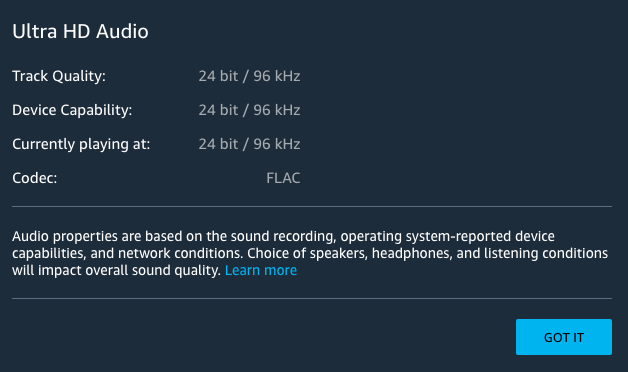Digital Audio Quality Explained Simply, Thanks Amazon!
Frequent visitors here know I’ve spent years preaching on the badness of lossy music. I was in countless thread battles on other sites too. After many years of that stuff I got tired of it and just decided to enjoy my lossless library of FLAC files on my PonoPlayer.
Then in 2019 Amazon Music HD came out. Lossless streaming all the way up into 24-bit? Huge library? Clients for everything? Holy shitcakes!
If Amazon does it maybe people will finally understand was my first thought.
I think so. Look at their Amazon Music app: this dialog is nearly perfect, and is available for every single song you stream from Amazon Music:

I mean, that’s about as clear as it can get. Even the playback signal chain is represented: First, at top, there’s the track quality, then there’s the playback device and it’s abilities, then there’s what they negotiate to deliver to your speakers based on current bandwidth.
You can’t improve down the chain. You need the good file to start with.
Your dialog will look slightly different, being custom to your device, your network, that moment, and that track. The player apps are smart enough to step it down and stream 16/44 or even lossy 🙁 versions of the song if conditions require it.
BTW Amazon calls their lossy stream format SD for Standard Definition, which is a compliment since it’s actually sub-standard audio. HD = cd quality 16/44 lossless, and Ultra HD is anything above that.
I have just (fall 2020) started seeing 24/192 tracks. Before it seemed like most UltraHD were up to 96k. Many are 88k, 48k, even 44k, but all are 24bit. Well done Amazon!
So yeah, I recommend Amazon Music HD to everyone now. I pay for the family plan to get it on all our devices, and since I’m a prime member it’s under $20/month.
